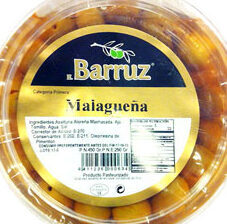Aceitunas a la malagueña - Barruz - 450 g (neto), 250 g (escurrido)
This product page is not complete. You can help to complete it by editing it and adding more data from the photos we have, or by taking more photos using the app for Android or iPhone/iPad. Thank you!
×
Barra-kodea: 8411236000634 (EAN / EAN-13)
Izen arrunta: Aceitunas verdes partidas aliñadas de la variedad Aloreña de Málaga
Kopurua: 450 g (neto), 250 g (escurrido)
Ontziratzea: en:Plastic, en:Terrine pot, es:Pasteurizado
Markak: Barruz
Kategoriak: en:Plant-based foods and beverages, en:Plant-based foods, en:Fruits and vegetables based foods, en:Vegetables based foods, en:Pickles, en:Olive tree products, en:Plant-based pickles, en:Olives, en:Cracked olives, en:Green olives, en:Green cracked olives, en:Marinated olives, en:Cracked marinated green olives
Etiketak, ziurtagiriak, sariak: en:Vegetarian
Origin of ingredients: Espainia
Manufacturing or processing places: Casarrubios del Monte, Toledo (provincia), Castilla-La Mancha, España
Traceability code: ES 21.022223/TO C CE, FABRICANTE Y ENVASADOR:, ACEITUNAS BARRUZ S.A.
Dendak: www.flamencochueca.com
Saltzen diren herrialdeak: Espainia
Matching with your preferences
Health
Osagaiak
Food processing
Gehigarriak
Ingredients analysis
Elikadura
Ingurumena
Carbon footprint
Ontziratzea
Transportation
Report a problem
Datuen iturria
Product added on by flamencochueca
Last edit of product page on by packbot.
Produktuaren orria -gatik editatua javichu, thaialagata.




